Blog Posts Tagged Heat Transfer Module
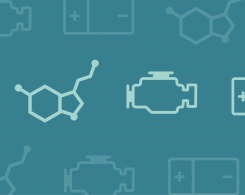
Optimizing Thermal Processes in Carbon Manufacturing with Simulation
A guest blogger from SGL Carbon GmbH demonstrates how his organization uses heat transfer simulation to optimize thermal processes in carbon manufacturing.

Common Pitfalls in Electrothermal Analysis
In the real world, electromagnetic heating often involves a nonlinear temperature. Learn some common pitfalls that occur during this type of electrothermal analysis and how to overcome them.

Using the Inflow Boundary Condition in Nonisothermal Flow Simulations
Nonisothermal flow is a multiphysics problem, as it combines CFD and heat transfer analysis. Learn how to implement the Inflow boundary condition when simulating these types of scenarios.

Modeling Phase Change in a Thermosiphon
A guest blogger from Noumenon Multiphysics writes about modeling phase change in a thermosiphon, a device that has been keeping houses warm since the 1800s.

Advancing Additive Manufacturing with Sequential Simulations
In some ways, additive manufacturing is like sewing or weaving. We talk to a professor of additive manufacturing about how sequential simulations can be used to analyze and optimize the process.
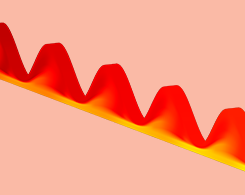
Comparing Static and Dynamic Wall Heat Exchangers with Simulation
We compare the performance and efficiency of static and dynamic compact wall heat exchanger designs using fluid-structure interaction.
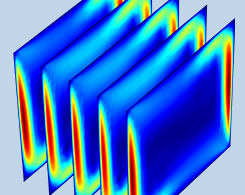
Simulating Natural Convection in Air with COMSOL Multiphysics®
From small electronic components to large buildings, natural convection is a transport phenomena found in engineering disciplines of all sizes. Here’s an example of natural convection in air.

Optimizing Thermophotovoltaic Designs with Heat Transfer Simulation
Thermophotovoltaic (TPV) systems, known for their flexible fuel choice options, immovable parts, and potential for efficient power generation, can be optimized with heat transfer modeling.
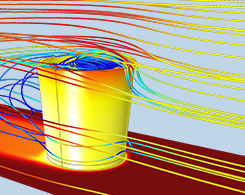
How to Model Moisture Flow in COMSOL Multiphysics®
Learn how to model moisture flow in COMSOL Multiphysics®, which you can apply to industrial examples such as building envelopes and food packaging.

Keynote Video: Modeling the Multiphysics Behavior of Nuclear Fuel
A laboratory engineer discusses using multiphysics simulation to understand the complex and challenging behavior of nuclear fuel. Watch his presentation and get a quick summary here.
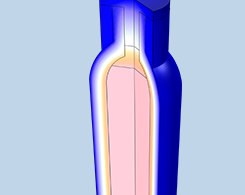
Predicting How Long Coffee Stays Warm in a Vacuum Flask
Do you use a vacuum flask to keep your coffee or tea warm? Try simulating the natural convection cooling in one of these containers to see exactly how long your beverage will stay warm.
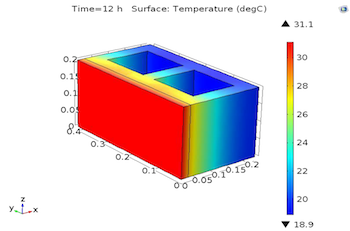
Studying the Thermal Performance of Phase Change Materials
Certain building materials, like plaster, are enhanced with phase change materials (PCMs) to assist in keeping buildings cool in the summer and warm in the winter. But how effective are they?
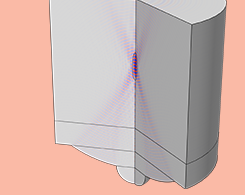
Using Simulation to Study Ultrasound Focusing for Clinical Applications
Guest blogger Thomas Clavet of EMC3 Consulting discusses the simulation of ultrasound focusing via phased array and geometrically focused probe designs for clinical uses.
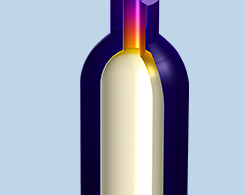
Can a Wine Cooler Actually Keep Your Beverage Cold?
When enjoying nice meals outside, some people use wine coolers to keep their beverages cold. But can a wine cooler actually keep a bottle of wine chilled, and if so, for how long?
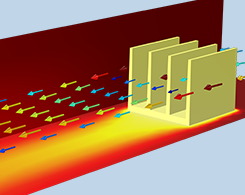
Comparing 2 Approaches for Modeling Electronic Chip Cooling
We go over 2 modeling approaches for electronic chip cooling problems. 1 way models the solid parts and a Convective Cooling boundary condition, while the other option includes an air domain.
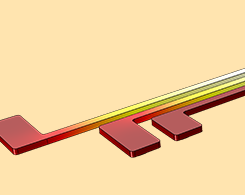
Optimizing the Design of Thermal Actuators for Use in Microsatellites
Microsatellites are replacing traditional large satellites in aerospace missions for gathering scientific data. Using simulation, we can optimize an important component of these devices.
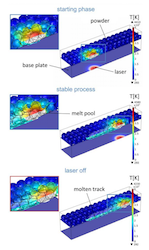
Analyzing Laser Beam-Matter Interaction in Selective Laser Melting
Selective laser melting is a common and important process in many types of manufacturing. You can model the interaction between the laser beam and matter for a closer look at this process.

How to Model Heat and Moisture Transport in Porous Media with COMSOL®
Modeling the transport of heat and moisture in porous media, like building envelopes and other construction materials, is a simple process with a predefined Heat and Moisture Transport interface.

How to Model Heat and Moisture Transport in Air with COMSOL®
First, we discuss how to model heat transport in moist air. Then, we add complexity by demonstrating how to couple heat and moisture transport in air in your simulation.

Studying the Artificial Ground Freezing Method with Simulation
Artificial ground freezing (AGF) is a valuable process in the construction industry. Researchers from China modeled groundwater flow to optimize an artificial ground freezing (AGF) process.
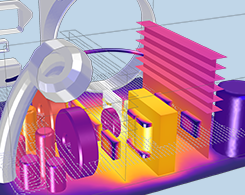
Modeling Natural and Forced Convection in COMSOL Multiphysics®
Get an overview of several approaches for modeling natural and forced convection in COMSOL Multiphysics®, starting with the simplest method and adding complexity from there.

Analyzing Heat and Mass Transfer During Cake Baking with Simulation
As you bake a cake, there are many complex heat and mass transport processes taking place behind the oven door. Take a closer look at the art and science involved in the cake baking process…
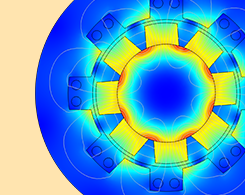
Simulating the Electrothermal Transients in Superconducting Magnets
In order to design superconducting magnets for a particle accelerator, such as the Large Hadron Collider at CERN, researchers need to simulate and optimize their electrothermal transients.
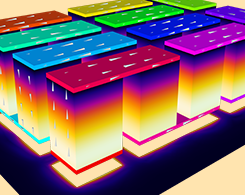
How to Analyze Thermoelectric Cooler Designs with a COMSOL App
A simulation application, such as one for a thermoelectric cooler design, can be used to test a variety of parameters in order to optimize a device for a specific use.
